Contents
Bleak is a small fish of the carp family. Despite the fact that she has a very modest size, her fishing is very reckless and exciting. Properly mounted tackle, as well as properly selected bait and nozzle, will allow you to count on interesting fishing.
Where to catch
Bleak is quite widespread and is found in various types of reservoirs:
- lakes;
- reservoirs;
- careers;
- large ponds;
- slow to moderate rivers.
This fish is not found in rivers with cold water and fast currents. It also cannot be found in small ponds and shallow marsh-type lakes, where an unfavorable oxygen regime is observed.

Photo: www.gruzarf.ru
Flocks of bleak do not stay in one place for a long time and constantly cruise around the reservoir in search of accumulations of food objects. This fish can be caught both a few meters from the shore, and at a great distance from it.
The bleak leads a pelagic way of life, feeding in the upper and middle layers of the water. However, if the population of this fish in the reservoir is very large, it can also seek food in the near-bottom horizon, which is due to high food competition.
Seasonal features of bleak behavior
To successfully catch bleak, the angler needs to know the peculiarities of its behavior at different times of the year. This approach will make fishing more meaningful and productive.
Summer
Summer is the best time for bleak fishing. During this period, she actively feeds and is well caught by various types of gear. Fishing starts at 6-7 in the morning and continues with short breaks until sunset. At night, flocks of fish sink closer to the bottom and stop feeding.
In summer, bleak is best caught in sunny weather with little wind. With heavy rainfall and strong waves, this fish goes to the depth, significantly reducing its feeding activity.
Autumn
In September, the bleak continues to adhere to the summer diet and is well caught with amateur gear during the daytime. By mid-autumn, its activity noticeably decreases, which is associated with a rapid decrease in water temperature. The fishing of this fish in October can be effective only in sunny, calm weather.
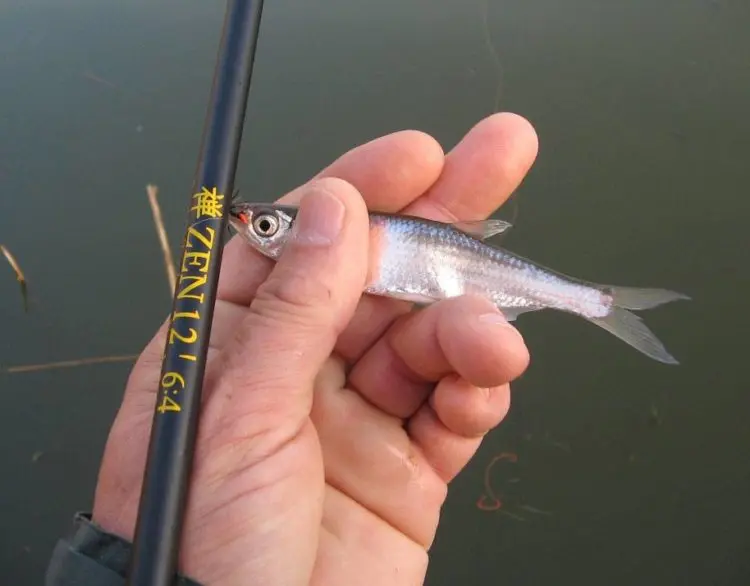
Photo: www.rybalka2.ru
In November, the bleak gathers in large flocks and goes to the deep parts of the reservoir, practically ceasing to feed. Late autumn catches of this fish are sporadic.
Winter
In closed reservoirs, bleak stands in pits in winter and practically does not feed. Some manifestations of fish activity can be observed only during prolonged thaws, when melt water begins to flow under the ice.
On the rivers, the situation with biting bleak in winter looks different. The first weeks of freeze-up, the fish adapts to new conditions and does not feed. At the end of December, it rises into the middle layers of the water and begins to show interest in food objects. However, the degree of its activity is much lower than in the summer.
Spring
Spring is a great time to fish for bleak. As the air temperature rises, the ice begins to melt rapidly, saturating the water with oxygen. The bleak standing all winter in the pits rises to the upper layers and actively moves around the water area in search of food, which is what anglers use.
After the ice melts, the fish settles at a depth for 5–7 days, and then begins to actively feed. In the middle of spring, the best bite is observed in quiet, sunny weather. With a sharp cold snap, accompanied by heavy rainfall, the bleak stops feeding.
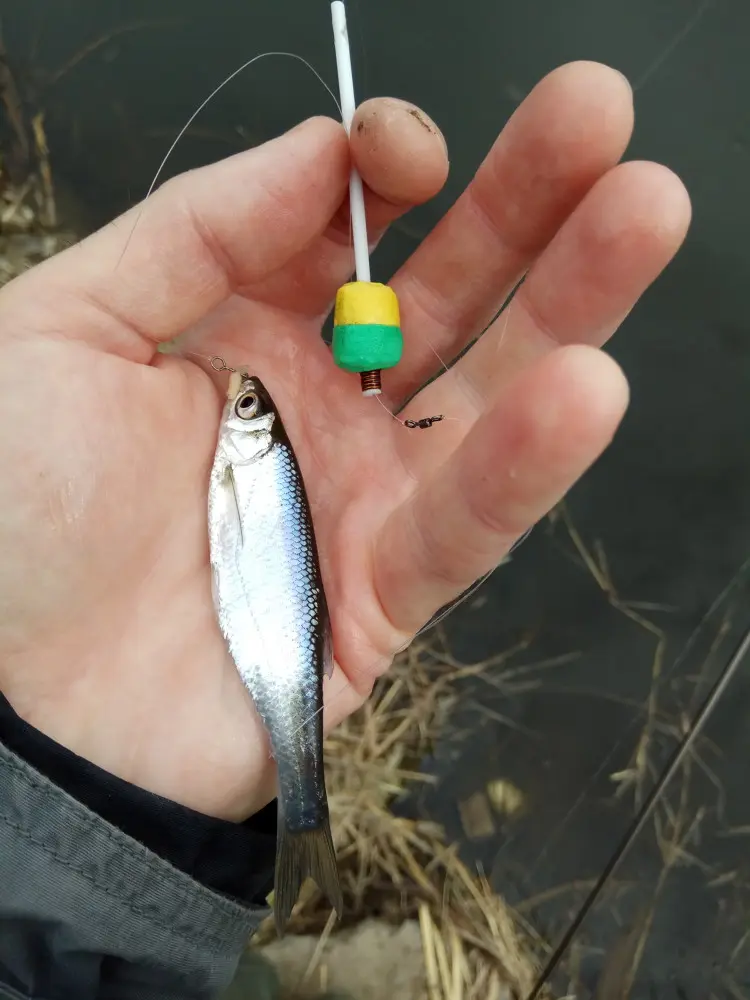
Photo: www.fish-hook.ru
In May, the spring feeding activity of bleak reaches its peak. She bites well in the daytime, greedily grabbing the nozzles offered to her.
Best bait
When fishing bleak, the choice of bait plays an important role. The nozzle used should not only provoke the fish to bite well, but also hold securely on the hook, which will significantly increase the rate of fishing.
Animal types of baits
At any time of the year, bleak responds well to animal types of baits. To catch this fish, they often use:
- maidservant;
- bloodworms;
- burdock;
- fat.
Oparysh It is considered the most versatile bleak nozzle. It holds the hook perfectly and attracts fish well in both warm and cold water.
To increase the attractiveness of maggots, they are painted in bright colors. This is easy to do with powdered food coloring by adding it to the jar where the bait is stored. The mouth of the bleak is relatively small, so the hook is usually baited with one large larva.
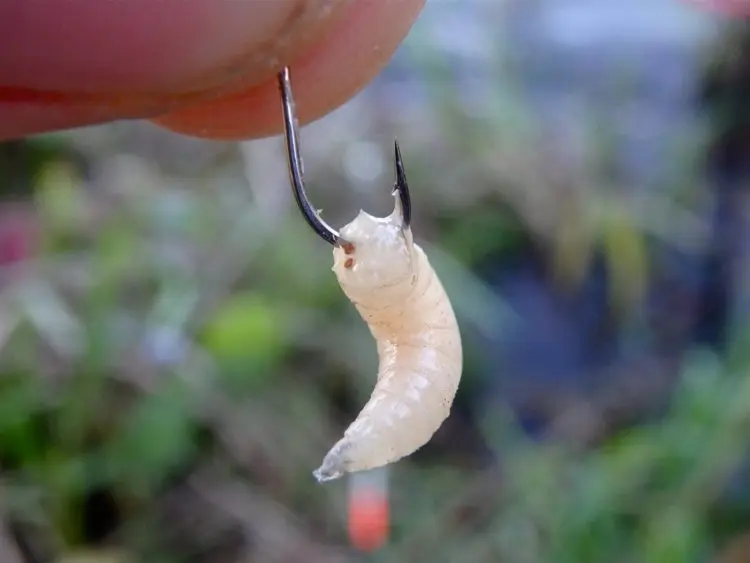
Photo: www.agrozrk.ru
This fish bites well throughout the year. on a bloodworm. 1-2 large larvae are planted on the hook. The only drawback of this bait is that after a bite it has to be changed to a fresh one, which reduces the rate of fishing.
Burdock moth larva used for catching bleak in winter. After baiting on the hook, this nozzle begins to secrete juice, which provokes even inactive fish to bite.
Fat also more often used in ice fishing. This animal bait has several advantages:
- holds securely on the hook and is able to withstand multiple bites without reattaching;
- has a specific aroma that bleak really likes;
- It has a white color that attracts fish from afar.
Before fishing, the lard is washed from salt and cut into small pieces, which are subsequently put on a hook one at a time.
Vegetable types of baits
In the warm season, bleak bites perfectly on vegetable types of baits. They do not hold as well on the hook as maggot or lard, but consistently show consistent results when angling in late spring and summer. The following baits are of greatest interest to fish:
- flour “chatter”;
- bread roll;
- cereals.
For fishing bleak, it is better to use not semolina, but flour “chatter”. When it enters the water, the delicate nozzle begins to quickly dissolve, forming a fragrant cloud of turbidity, which provokes the fish to bite. A catchy bait is prepared in several stages:
- Pour 50 g of wheat flour into a clean jar.
- Add a pinch of vanilla powder to the flour.
- Mix the contents of the container.
- Warm water is added in portions to the jar, constantly stirring the contents of the container with a stick.
The result should be a bait that has the consistency of batter and has a pleasant vanilla flavor. For the convenience of planting, the “talker” is placed in a disposable syringe, from where it is subsequently squeezed out in portions and wound on a hook.
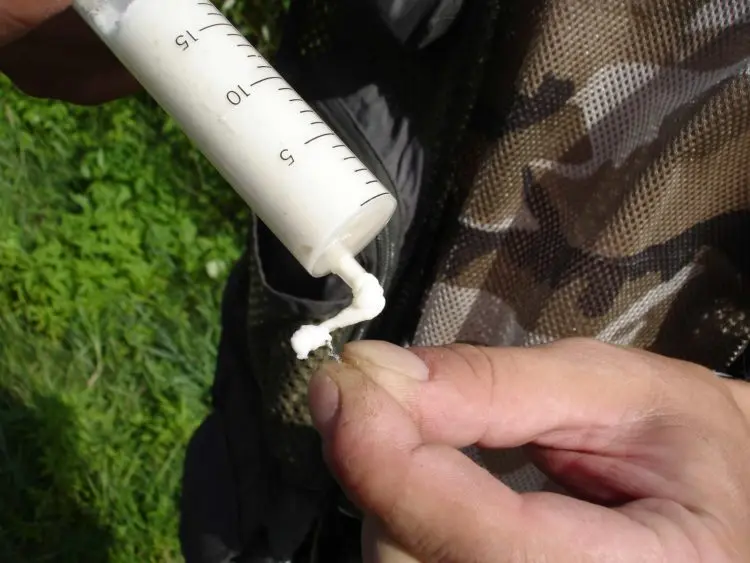
Photo: www.kaklovit.ru
Nozzle of wheat bread also very effective when fishing bleak in warm water. Make it very easy. For this you need:
- Separate the crumb of wheat bread.
- Tear off a small piece from the crumb.
- Roll a piece of crumb into a small ball measuring 3 mm.
The resulting spool is put on a hook and slightly flattened with your fingers. It is important that the bread used to prepare the bait is fresh.
scalded with boiling water oat flakes work great when fishing for bleak in still water. To prepare them you need:
- Place a handful of cereal in a colander.
- Scald the cereal with boiling water.
- Wait for the water to drain a little.
- Spread the flakes on a cloth or sheet of paper until completely cooled.
On the hook, the flakes are planted one at a time, having previously folded them in half. The effectiveness of the oatmeal nozzle will increase if you process it with a “dip” with a sweet aroma.
Lure
Properly prepared bait is the key to successful bleak fishing. Without this component, it will not be possible to achieve a good result.
For warm water
A bait for fishing in warm water should have the following characteristics:
- fine grinding;
- the presence of instant components;
- white;
- rich aroma.
The attracting composition should contain only fine particles, which will sink as slowly as possible, concentrating the fish in the water column. The absence of large components will not allow the fish to quickly get enough and leave the point.
Photo: www.activefisher.net
The presence of instant components in the composition of the bait in the form of powdered milk or baby food will allow you to create a stable column of fragrant turbidity in the water. The resulting cloud will quickly attract and hold the fish at the fishing point for a long time.
When fishing in warm water, it is better to use a bait that creates a white cloud of turbidity to attract bleak. To achieve a similar effect, food coloring powder of the corresponding color is added to the dry or moistened composition.
The bleak has a very good sense of smell. She is able to capture the smell of bait for many tens of meters. That is why the compositions used must have a rich aroma. Mixtures with odors work better in warm water:
- vanilla;
- biscuit;
- caramel;
- tutti-frutti;
- various fruits.
If a dry flavor is used, it is added to the composition before the water is added. Liquid odorous substances are poured directly into the water, which will moisten the bait.
One of the effective bait compositions used to attract bleak in warm water contains the following elements:
- breadcrumbs – 1 kg;
- corn flour – 500 g;
- finely ground wheat bran – 300 g;
- ground hemp seeds – 300 g;
- dry milk – 200 g;
- white dye;
- flavoring.
If fishing takes place at close range, after mixing the dry ingredients, they are moistened in such a way that a composition with the consistency of porridge is obtained. This will create a more stable column of turbidity.
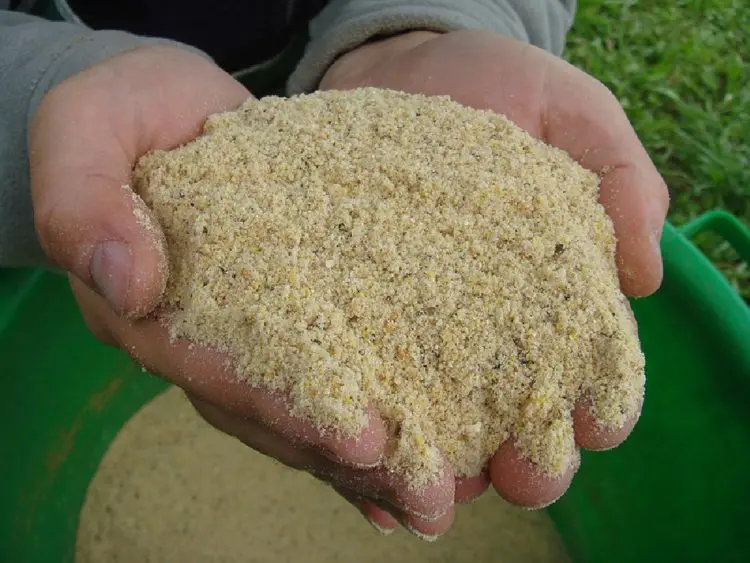
Photo: www.sazanya-bukhta.ru
When fishing is carried out at a long distance, the mixture is moistened so that the lumps formed from it break when they hit the water. This will allow feeding with a slingshot or feeder feeder.
For cold water
For effective bleak fishing in cold water, you will also need to use a bait mixture. In such conditions, it is necessary to use attracting compositions with the following characteristics:
- fine grinding;
- light or red;
- weak aroma;
- the presence of animal components.
Autumn and winter bait should also consist of fine-grained particles floating in the water column. In cold water, bleak responds better to mixtures of light and red.
At low water temperatures, bleak is suspicious of foreign odors. That is why the mixture used in cold water should have a mild aroma. It is good if animal components are added to the composition in the form of feed bloodworms or dried daphnia.
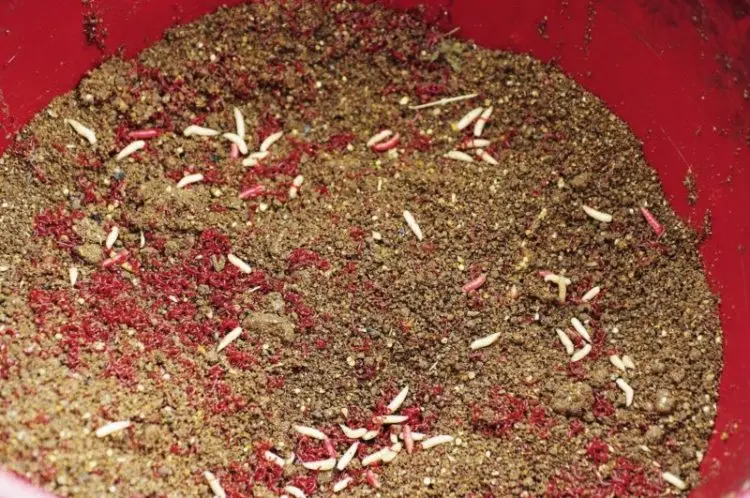
Photo: www.ribxoz.ru
You can prepare an effective bleak bait for fishing in cold water from the following ingredients:
- bread crumbs – 500 g;
- finely ground wheat bran – 200 g;
- dry milk – 100 g;
- fodder bloodworm – 100 g;
- red powder dye.
Dry ingredients are placed in a plastic bottle and brought to a state of liquid puree with warm water. Bloodworms are added immediately before fishing. To maintain a constant column of turbidity, the composition is poured into the well in small portions every 3-4 minutes. It is more convenient to prepare such bait at home.
Tackle and fishing technique
You can catch bleak with various types of amateur gear. Properly selected equipment elements and well-executed installation will allow you to count on exciting and prolific fishing.
fly rod
A float rod with a “deaf” snap is most often used by anglers for fishing bleak in open water. Its kit includes:
- telescopic rod 2,5–5 m long;
- monofilament fishing line 0,1–12 mm thick;
- bleak float with a carrying capacity of 0,3–1 g;
- a set of small weights-shots;
- monofilament leash 13–17 cm long;
- hook No. 22–18 (according to international standards).
For bleak fishing, it is advisable to take modern telescopic rods made of carbon fiber. They will allow you to actively work with tackle for several hours without experiencing fatigue.
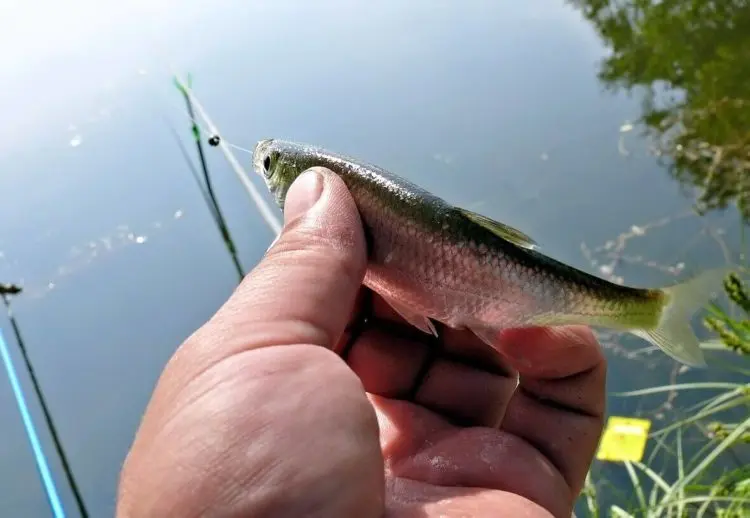
Photo: www.rybalka2.ru
If the bleak actively feeds and is not afraid to come close to the shore, it can be successfully caught with short rods 2,5–4 m long. When the fish is careful, “sticks” 4,5–5 m long should be used.
A connector is fixed at the tip of the fly rod. This element is necessary for attaching equipment.
When fishing with short rods equipped with ultra-light floats with a carrying capacity of up to 0,5 g, a fishing line with a diameter of 0,1 mm is used as the main one. When fishing is carried out with longer “sticks” equipped with larger bite signaling devices, monofilaments 0,12 mm thick are used.
A fly rod for bleak fishing is equipped with a light float, which must have:
- elongated body shape;
- thin antenna with neutral buoyancy;
- long lower keel.
These floats are highly sensitive. They come into working condition almost immediately after casting, which is important when it comes to catching fish that can grab the bait at the very surface.
On rods up to 3 m long, floats with a carrying capacity of 0,3–0,5 g are usually installed. Longer “sticks” are equipped with signaling devices with a load weight of 0,6–1 g.
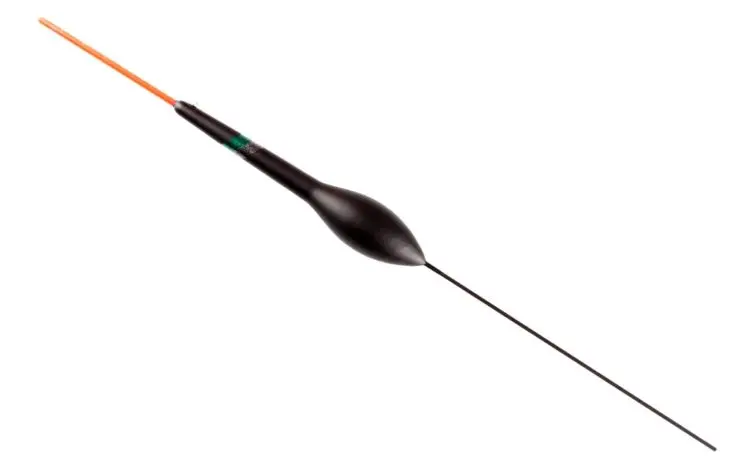
To fix the float on the main monofilament, the fishing line is first passed through the ring located near the signaling antenna, and then threaded through the silicone cambric, which is mounted on the keel. This method of fastening allows you to quickly change the horizon of fishing.
In this type of rig, it is better to use small lead shot weights used in sport fishing. They do not injure the fishing line when moving and allow you to load the float as accurately as possible.
Since fishing is usually carried out at a depth of no more than 1 m, lead pellets are distributed along the line in such a way that their main part is near the float. Only one weight is installed near the connecting loop of the leash. This installation provides:
- maximum sensitivity of the equipment;
- slow drop of the hook with the nozzle;
- invisibility equipment for fish.
Mounting, assembled according to this scheme, is extremely rarely confused, which is very important, since when catching bleak, you have to perform frequent recasting of the equipment.
Leashes are made from high-quality fishing line with a thickness of 0,07–0,08 mm. They are attached to the main monofilament using the loop-to-loop method. Thinner monofilament should not be used, as this will increase the chance of tangling the rig.
To catch bleak, small hooks made of thin wire are used. It is better to use models that have a spatula rather than a ring as a connecting element, as they are lighter.
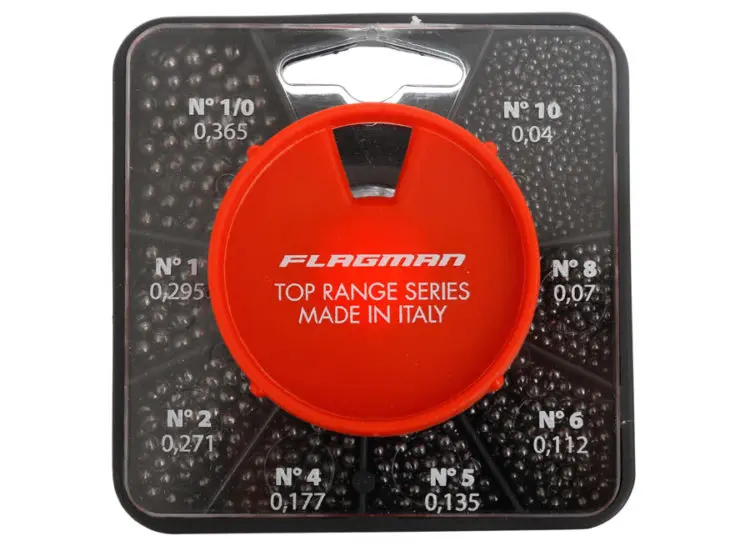
If a bloodworm is used as a nozzle, the tackle is completed with a red hook No. 22–20. When the bait is maggot, bacon or vegetable baits, a model No. 18 of a silver color is tied to the leash.
During the open water period, flocks of bleaks are easy to detect by small circles diverging on the surface. When a promising place is found, the angler needs to:
- Prepare bait (moisten and let it brew).
- Prepare a workplace (install a fishing chair, lay out a fish tank, place a nozzle at hand).
- Collect gear.
- Adjust the descent of the float so that the nozzle is 30–100 cm from the surface.
- Put the bait on the hook.
- Throw a few handfuls of bait directly into the float.
- Wait for the approach of a flock of bleak.
Even in the absence of bites for 10-20 minutes. you need to continue to feed the point. If bleak is present in a pond, it will certainly suit the smell of a fragrant bait.
When the flock approached the point, it is worth experimenting with the depth of fishing, changing the descent of the float. This will find the horizon with the maximum concentration of fish.
Match rod
There are reservoirs in which the bleak behaves extremely cautiously and does not come close to the shore. This is usually associated with a small concentration of fish and low food competition. In such conditions, match tackle is used, consisting of the following elements:
- match rod 3,9 m long with blank test up to 15 g;
- high-speed inertialess coil series 3500;
- sinking monofilament 0,14 mm thick;
- float class “wagler” with a total load capacity of 4-6 g;
- connector for attaching a bite signaling device;
- a set of weights-shots;
- monofilament leash 13–17 cm long;
- hook number 22-18.
A light class match rod allows you to easily cast bleak equipment at a distance of up to 30 m. In most cases, this is quite enough.
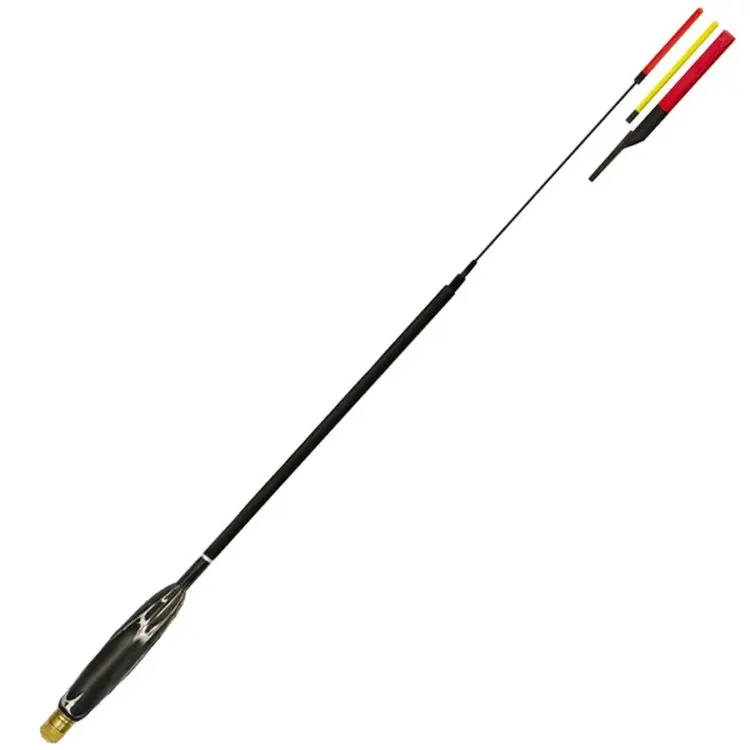
“Inertialess” mounted on a match rod must have a large gear ratio (at least 5.2:1). This will allow you to quickly exhaust the equipment from a long distance and significantly increase the pace of fishing.
A sinking fishing line is wound on the spool of the reel, which reduces the pressure on the rig from side wind and surface current. This makes it possible to keep the float at the fed point longer.
The waggler class float used must have a built-in load of 70–80% of the total lifting capacity. Such models allow you to perform accurate casts and minimize the risk of overlapping mounting during flight and splashdown.
Since fishing is carried out at a depth of no more than 1,5 from the surface, the float is performed not in a sliding, but in a fixed version. On the fishing line, the bite signaling device is attached using a connector, which is a wire loop equipped with silicone tubes.
To load the Waggler, small pellets are used, the main part of which is fixed near the float. Near the connecting loop of the leash, one load-shepherd is placed.
In match gear, leads and hooks are used with the same parameters as in a fly fishing rod. The leader element is attached to the main line through a small swivel, which prevents the thin monofilament from twisting when unwinding the equipment.

Photo: www.activefisher.net
When fishing with a match rod, the same fishing technique is used as for fly gear. The only difference is that the bait is thrown not by hand, but with the help of a special slingshot.
Feeder
The feeder belongs to the bottom types of gear, however, with a properly assembled installation, it allows you to successfully catch bleak in the middle layers of water. Its package includes:
- light feeder rod of the picker class;
- “Inertialess” series 2500;
- braided cord 0,08–0,1 mm thick (0,3–0,4 PE);
- short shock leader made of fluorocarbon fishing line 30–40 cm long;
- feeder feeder;
- monofilament leash 0,08 mm thick;
- hook number 22-18.
The feeder rod used should be 2,7–3 m long, test up to 40 g and soft blank. Models with these parameters are best suited for bleak fishing when light feeders and thin leashes are used.
The reel installed on the feeder should wind the cord evenly and have a fine adjustment of the friction brake. It is advisable to use models with a gear ratio of at least 4.8:1, which will allow you to quickly unwind the equipment, providing a high rate of fishing.

Photo: www.gruzarf.ru
A thin braided cord is wound on the spool of the inertialess reel. Due to zero stretch, this monofilament increases the sensitivity of the tackle, allowing you to register accurate bleak bites.
A shock leader is tied to the end of the cord (with a counter knot), which performs several functions:
- protects the end part of the thin “braid” from damage caused by contact with bottom objects;
- makes the rig inconspicuous for bleaking;
- prevents tangling of the installation.
The shock leader is made from fluorocarbon monofilament 0,24 mm thick. Such a fishing line has increased rigidity, which reduces the risk of tangling the installation during the fishing process.
The bleak feeder is equipped with a light feeder weighing 15–20 g. Its volume should be no more than 50 ml, which will save on bait.
The length of the leash used should be 100-120 cm. On such a leash element, the nozzle will soar for a long time in the water column – this will give the bleak more time to react to the bait until it sinks to the bottom.
For fishing bleak, the Gardner loop feeder installation is well suited, which is knitted according to the following pattern:
- A shock leader is tied to the main cord.
- At the free end of the shock leader, a small “blind” loop with a diameter of 0,5 cm is made.
- At 15 cm above the small loop, a “blind” loop with a diameter of 6 cm is made.
- A feeder is attached to a large loop (using the loop-to-loop method).
- A leash with a hook is attached to a small loop.
Such a rig is easy to manufacture, not prone to tangling and does its job perfectly, transferring delicate bites of bleak to the tip of the feeder.
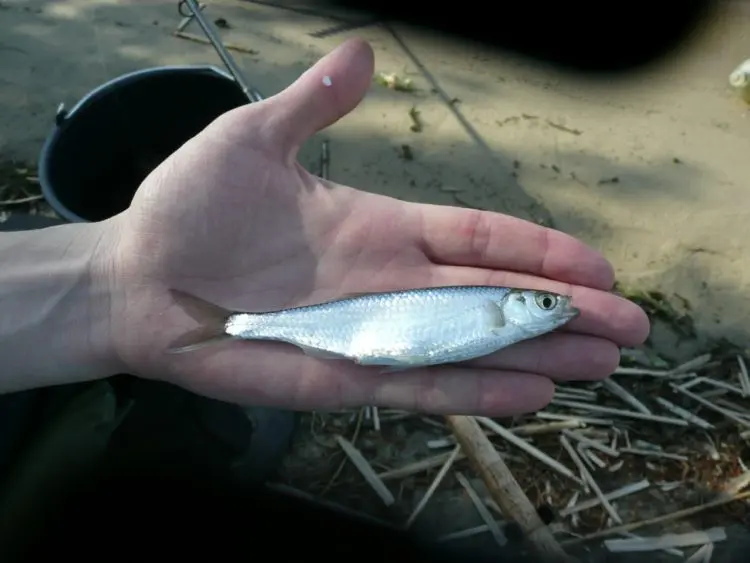
Photo: www.img-fotki.yandex.ru
The technique for catching bleak with feeder tackle is as follows:
- The angler is mixing the bait.
- Prepares the workplace.
- Gathers gear.
- Casts the feeder at a distance of 15–35 m.
- Fixes the casting distance by clipping the cord onto the spool of the reel.
- Pulls out equipment.
- Clog the feeder with a moistened mixture.
- Feeds the point, performing 5-6 casts of a full feeder in one place.
- Again clog the feeder with a moistened mixture.
- Putting bait on the hook.
- Drops a rig.
- Puts the rod on the racks.
- By rotating the handle of the reel, it tightens the cord.
- Waiting for bites.
If within a minute there was no bite, you need to rewind the equipment again, check the nozzle and, after clogging the feeder, again cast to the selected point. In the process of fishing, one should not allow the column of nutrient turbidity to disappear.
When angling the bleak, do not tightly clog the feeder feeder. Nutrient particles should be washed away as the container falls to the bottom, forming a cloudy column that attracts fish.
Mormuscular tackle
Mormus tackle is used for fishing bleak from ice. This fishing gear includes the following items:
- winter fishing rod of the “balalaika” type;
- monofilament 0,05–0,06 mm thick;
- sensitive nod 5–7 cm long;
- little mormouse.
When fishing bleak from ice, it is better to use a balalaika-type fishing rod. It fits comfortably in the hand and allows you to quickly change the fishing horizon.

Photo: www.pp.userapi.com
In winter, the feeding activity of bleak is reduced, and the fish behaves more cautiously than in warm water. These are due to the use of thin fishing lines with a thickness of not more than 0,06 mm.
A sensitive nod is installed at the end of the fishing rod. This detail will allow you to register careful bites of the bleak and give the mormyshka different animations.
The diameter of the used mormyshka should be about 2 mm. It is better to use dark-colored tungsten models equipped with hook No. 20.
The technique for catching bleak on mormyshka from ice is as follows:
- The angler drills 3-4 holes at a distance of 10 m from one another.
- Feeds each of the holes.
- Gathers gear.
- He puts bait on the hook of the mormyshka.
- It bypasses the holes in turn, spending no more than 2 minutes on fishing each.
If a bite occurs in one of the holes, the angler focuses on it and begins to feed, regularly topping up small portions of food.
Winter fishing rod with float
Bleak from ice can be very successfully caught with a winter fishing rod with a float. This tackle includes:
- balalaika-type fishing rod;
- the main monofilament with a thickness of 0,1 mm;
- float with a carrying capacity of 0,3 g;
- several weights-shots;
- a leash made of fishing line 0,06 mm long 12–14 cm;
- hook number 22-20.
The winter float rod must be loaded in such a way that the main part of the pellets is 40 cm above the hook. Near the loop connecting the leash and the main line, only a small sinker-shepherd is installed.
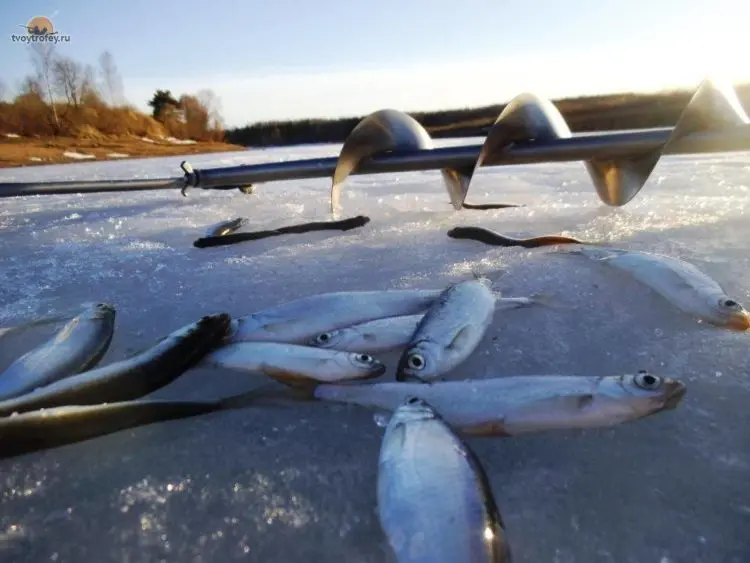
Photo: www.vseeholoty.ru
It is advisable to use this tackle only at positive temperatures, when the hole does not freeze over. The technique of fishing bleak on a winter fishing rod with a float is no different from that used when fishing with a jig.










